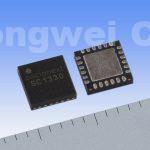The demo, which follows a September 2022 demonstration of outdoor communications, advances ZETag adoption for a wide range of products in the IoT consumer and industrial markets.
The latest demonstration experiment verified the performance in an asset management use case involving indoor operation, an environment where communication is more challenging than outdoor.
The September 2022 effort involved members of the ZETA Alliance jointly conducting an outdoor communication testing of an Advanced M-FSK-compatible tag evaluation system that demonstrated greater reliable communications than conventional tags.
The experiment used the first ZETag with SC1330A-equipped from a trial production by Toppan Inc., a member of the ZETA Alliance. The ZETag using the SC1330A LSI supports Advanced M-FSK modulation. Commercial production commenced in March 2023.
The demonstration tags were attached to objects (assets under management) in Socionext’s Kyoto office and their continuous presence within the area of interest was verified over a period of about two months using a well-positioned antenna that received regular data transmissions from the tags.
The results proved the practicality of asset management automation using tags integrated with the SC1330A Advanced M-FSK LSI equipped with just a single access point capable of supporting communications with 50 tags spread across two floors.
Meanwhile, Techsor has developed a visualization platform using Microsoft Power BI that provides details of asset inventory and temperature changes in indoor environments.
Tags:
– Transmit ID information at preset intervals or when acceleration (vibration) is detected
– Transmitted data also includes temperature and GPS information (outdoor use) collected by the tag
– 920MHz band, 10dBm (10mW)
Details:
1 Tags were attached to the rear of display monitors located throughout floors 6 and 7 of the Socionext Kyoto office (50 monitors uniformly distributed across the office)
2 The tags transmitted their ID data and ambient temperature measurement once every 30 minutes. Transmission was also triggered by activation of the tag’s accelerometer.
3 A single access point was installed on floor 7 and used to receive transmissions from tags on floors 6 and 7 for the duration.
4 The collected data was analyzed to ascertain the appropriate transmission interval for asset management and to study how best to present the data in the application.
5 The data was also analyzed to assess the benefits of using the temperature and accelerometers included in the tag.
Results:
The demonstration experiment confirmed that, by taking advantage of Advanced M-FSK modulation to improve sensitivity in indoor spaces where wireless communication can be difficult, it is possible to use a single access point installed at an appropriate location to automatically verify the presence of a large number of items spread across two floors, each with approximately 3,700m2 of floorspace.
The demonstration experiment also confirmed that data collected from the temperature sensor in the Toppan tags could be used for purposes other than asset management, such as monitoring the temperature in the office.
Also, Microsoft Power BI was used to build a real-time platform for presenting the data, which was retrieved from the Toppan ZETagDRIVETM platform via an API.
Together, these results demonstrated the benefits of the tags both for tracking asset inventory and for environmental sensing
View more : IGBT modules | LCD displays | Electronic Components